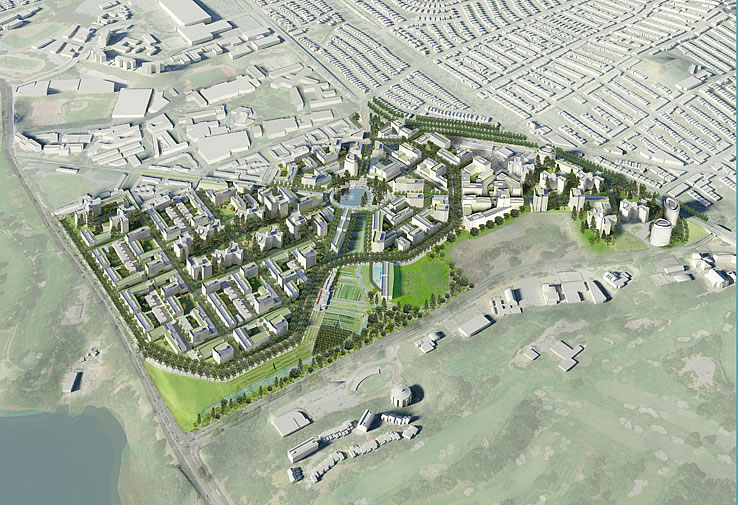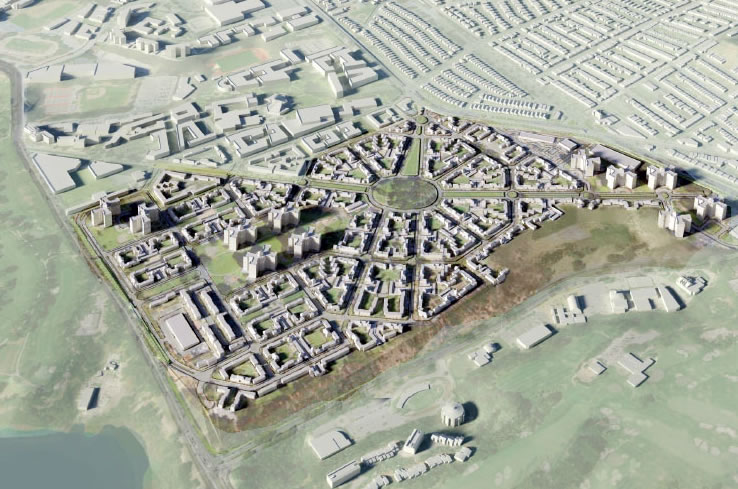Approved by San Francisco’s Board of Supervisors by the narrowest of margins three years ago, the redevelopment plan for Parkmerced – which includes the construction of nearly 5,700 net new residences in the southwestern neighborhood – has been tied up in a legal battle since 2011.
Last week, California’s 1st District Court of Appeal unanimously ruled in favor of the plans for redeveloping Parkmerced, effectively clearing the way for the project to commence, an ambitious project designed by SOM which will take a couple of decades to complete.
In addition to the 5,700 new apartments, the plan for Parkmerced includes a network of new neighborhood parks, athletic fields, plazas, greenways and even an organic farm; new underground garages on the west side of the site to discourage casual usage by residents concentrated on the eastern side; and a rerouting of MUNI’s M Ocean View line from 19th Avenue through the development along with re-designed public streets, bike paths and other transportation improvements.
Originally developed to house veterans returning from World War II and designed to be “a city within a city” by architect Leonard Schultze and Associates, and with landscape design by Thomas Church and Robert Royston, Parkmerced was named to the Cultural Landscape Foundation’s “Marvels of Modernism” list in 2008.


A few *decades* to complete?!
There is a stretch of I-5 in Stockton, about 3 miles, that has been under construction (just for repairs) for over 2 years now. At this pace, to build a transcontinental highway system would take over 2,000 years.
This site reported that there were 3,600 additional people employed in San Francisco last month.
For the sake of argument, let’s assume this happened every month and that they were all from outside the city and wanted to live here. In that case, the net 5,700 from Parkmerced wouldn’t even absorb two months of inflow. However, it takes ‘decades’ to build something with such a minor impact! How can that be?
Part of the reason this project will take so long is because of the complete re-design of the property. Since they are making way for more green space, some buildings will be demolished. These are buildings that people currently live in, so they will have to find replacements for these people. The properties owners have vowed that no one will be displaced and rent control will continue. To keep this vow, the construction will take longer. Also, it’s an expensive project, so they’re putting the cost out over time.
A large part of the “new” green space will be the balconies on the new 3,5 and 8 story towers. Existing green spaces will be largely eliminated as well as countless trees.
Three stories is a tower?
5 stories is a tower?
Today I learned I live in a tower.
i don’t see why we have to dance around this all day. just build a midrise- like 20-30 stories and BOOM more greenspace, same (if not larger) # of units, smaller building footprints. #growupsf
Well, not “countless” trees. It will a number and probably not all that many.
#math
Already ample green space near by so no issue
Did you even look at the plan? There’s an entire swath of buildings along the southern boundary that are coming out.
How long did it take to build and lay out the entire city of SF? Hint: it wasn’t “decades.”
Uh, it was at least 100 years… which is “decades”. If you look at maps from as late as the 1940s, you see swaths of the outer Sunset that and along the southern boundary of the City that are completely undeveloped. (And don’t confuse street grid maps, which as early as the 1910s had laid out the bulk of the grid from bay to ocean, with actual development.)
Parkmerced’s plan would more than double their number of residential units. Decades seems like a long time, but I’m not aware of any other comparable sized neighborhood in the western half of SF that expects to double in the same timeframe.
FWIW, those 3,600 additional employed people do live in San Francisco. That stat is for residents of SF, not for where they work. It counts the same for someone that lives at Parkmerced and works in San Mateo as if they work downtown or from home. There’s another stat for jobs in SF, about 45% of which are filled by people that do not live in SF.
Re: numbers, because this isn’t the only development happening in the City
And re: timing, because you’re talking about a complete redevelopment of an area that’s already fully built out (albeit at a lower density) and occupied. Residents have to be moved, current buildings razed, and new buildings built, all while not just the surrounding neighborhoods but the rest of Parkmerced itself remains “in use” and active.
If you have about $1.5 billion and the ability to relocate every resident (in this housing market!) somewhere else, to do it the redevelopment all at once, I’m sure the City would be happy for you to take assignment of the Development Agreement…
The city has a clear incentive to slow the process down as well, to ensure that all prices continue to accelerate at the same or higher rate, thus reaping property tax windfalls.
The same property tax windfall could happen with more units built faster (and thus increasing supply faster and holding prices down more), but that would require additional outlays from the city for increased infrastructure.
That’s pure speculation on your part. I don’t think The City has a “clear incentive” as you suggest. I would agree that the bureaucracy of the Planning and Building Dept, and the Planning commission is full of problems causing the process to be very slow. I don’t believe it’s intentional, it’s just stuck.
I didn’t say that it was intentional. I said that a clear incentive exists. Biiiiigggggg difference.
Not clear at all. Every delay risks a project not completing or being scaled back.
Long delays risk a market downturn. There are buildings being built in this boom on lots slated to be built when the dotcom bust happened, like the new linkedin building at Howard and 2nd.
Funny to imagine a city that can barely time the traffic lights being able to time the market so as “to ensure all prices continue to accelerate ….”
Maybe they hide a few evil geniuses behind all the mediocrities.
They don’t have to “time” anything. Delaying building allows less supply to exist AT ALL TIMES. Which means that the supply that is already here is worth more than would be the case with additional supply.
The incentive has absolutely nothing to do with timing the market or anything complicated like that. It’s basically less development = existing housing is worth more without having to invest anything. New housing requires investments of various types, preventing or delaying housing doesn’t.
Slowing the supply of additional buildings may or may not increase the value of the existing properties. It depends on the mix of what is already built and what could be built without the restrictions slowing the building.
Mission Bay is certainly much more valuable since it has been built up and will become even more valuable as the building continues. I think it has also helped to increase the value of the adjacent neighborhoods and possibly increased the value of more distant areas because they also benefits from the jobs, services, and parks there.
Also, the tax benefits to the city of inflating the value of existing properties is limited by prop 13.
Seems your logic is that less development somehow increases the total tax base for the city and more development somehow lowers the total tax base for the city. I don’t think it tends to work that way.
Mission Bay is more valuable, but the remainder of SF real estate is likely not that way.
My logic does not at all match your assumption. I’m specifically talking about already built up areas where rebuilding requires massive infrastructure investments from the city. The more that those can be spread out, the more annual budget money can be shifted toward pensions and salaries for existing employees.
Decades. I’ll admit to knowing virtually nothing about construction. Just seems to me if this were 100 years ago this would be built by next year, no? I have no concept for why construction projects in the US seem to get slower as time goes on. I mean, Manhattan grew very impressively in the early 20th century, is such a thing even possible now?
workers rights, labor unions, max number of hours onsite, safety regulations, sf construction unions are incredibly costly compared to “at will”, and city involvement. labor in the US is more expensive than materials.
Yes, just repeating what others have said, but Mission Bay (which to some degree had the advantage of being a tabula rasa) was also projected to be built over 20 to 30 years. The Redevelopment Area was established in 1998, and things developed slowly for a few years, but due to UCSF taking major chunks, as well as the recent boom it’s looking to be “done” early. Any projection of time for Park Merced is going to take into account the complications of developing within an already developed neighborhood, as well as the inevitability of real estate cycles. I’m sure, with the right economy, that the whole plan COULD be completed sooner.
Is Greystar still property manager for Park Merced?
Yes, Greystar is still the property manager and this change in managers is relatively new.
I like the changes , BUT , would not have been against 1/3 of the buildings adding at least another 50% in height ,
but its SF so the change though slight will still be significant for those living in that development
Visual simulations fail to show awful hideous hillside housing construction project being built by Comstock along Brotherhood Drive (shown as open space buffer to the project!). Comstock’s project not only felled an entire Monterey Cypress woodland, but creates a soon to be traffic cluster @*$& along Brotherhood Way. I guess it was SF’s way of saying they didn’t care about the schools and churches along that area. Good luck getting thru there once this project is constructed.
That’s a horrendous traffic-choked auto-oriented area already. Hopefully the churches will decide to sell and we can properly redevelop the entire area.
Nice anon. Forget about that the area was originally designed to cluster those religious orgs. They, and their associated educational indoctrination centers can move to Daly City like the cemeteries. Who needs culture anyway when we can have more generic high-rise condo apartments?
“culture”
This development looks like a giant UK council estate — long, thin buildings and empty courtyards.
How did Park LaBrea (it’s bigger brother down in Los Angeles) have a greater density from its creation? They put up gates on Park LaBrea about 15 years ago and rents soared after that. Is Park Merced gated?
What do you mean by gated? Park LaBrea presents somewhat of a wall to the arterial streets it abuts though you can still pass through it.